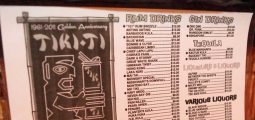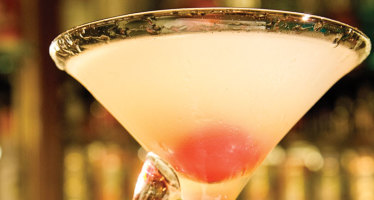A Color-Code for the History of Wine

I’m sure that somebody somewhere has written a comprehensive book on the history of wine. Surely it must be one thick book, since wine dates as far back as the written page, or more likely, the chiseled rock.
If we fast forward through the prehistoric era of caveman chianti, legends of the ‘big boom’ that initiated the modern era of wine would probably begin with stories of vino tinto, vin rouge or vino rosso. The term Dago red was a familiar slang term used for the homemade wines of many Italian Americans (even though the ‘D word’ is quite disrespectful, such a term was typically not derogatory as long as you were speaking of the wine and not the person).
All of these terms mean only one thing – red wine. Whatever your preferred language, such a description was all the information that was needed. The actual grape type used to make the wine was not important. Neither was the vineyard location. The fact that the wine may taste different with each batch – sometimes sweet, sometimes dry – was also not important. It was red and it made people happy; Period. There was no need to muddle things up with technicalities.
Then we discovered colors. Pink became the new red, and white zinfandel was born. No one seemed to care that the wine wasn’t actually ‘white’. It was usually some shade of pink, or sometimes a disgusting orange, but never white. Never mind that the juice bore about as much character resemblance to the actual zinfandel grape as Britney Spears does to Mozart. It didn’t matter, it was sweet and cold and yummy – and wine looked pretty in pink. But we humanoids can only consume so much Kool Aid, and hundreds of headaches later we decided to find a new color.
So we moved on to the white stuff. White was safe. White goes with everything, right? And it didn’t stain the carpet – or your teeth – like the red stuff. But the word “white” was boring and already misused on the aforementioned vino pinko. We needed a new name, something that sounded exotic and sophisticated. French words always sounded cool, so we called our white wine chardonnay. Mind you, most consumers didn’t know their chardonnay from shinola. Nor did they care, as long as it was white and served über cold. And it was SO fun to say that new word – especially if we were within earshot of, well, anyone. People weren’t particularly interested in the fact that this was a well-respected grape type of noble Burgundian origin. It wasn’t until much later that the masses discovered that the word chardonnay was actually supposed to mean something. Kind of like that corsage we gave our first prom date (sigh).
By now we have come full circle. Having exhausted the three color wine box of crayons, we’ve moved back to the red stuff. Only this time we crave something new. Cabernet and pinot noir are terrific, but we’re a bit restless with such stalwarts. As a result, blended red wines, composed of multiple wine varietals are becoming increasingly popular. Without getting too technical, these wines do not restrict the winemaker to predominantly use one type of varietal grape in the bottle. Without such restrictions the winemaker’s creativity can frequently shine. These red blends can cover a wide range of flavor profiles, from the big and bold to the smooth and elegant.
The Godfather of such red blends would have to be the Super Tuscans of Italy. With its origins in the late 1970’s, a number of newer generation Italian winemakers felt that the traditional chianti rules in Tuscany were too restrictive, thus inhibiting their ability to make the best wines possible. Blending nontraditional grape types such as cabernet and merlot with their indigenous sangiovese grape produced some outstanding wines. Thus, by shunning age-old Italian regulations and foregoing the traditional chianti label on their wines, the unofficial “Super Tuscan” category was born. These Super Tuscans provided a template for many of the red blends we see on store shelves today.
But these red blends can be more than a bit confusing. Without searching the fine print on the back label or even online, it may be difficult to ascertain exactly what is in the bottle, let alone the flavor profile or style of such wines. Perhaps this is by design. Winemakers of red blends may want us to sip without any preconception as to what his or her wine should taste like. Undoubtedly these red blends require a trusted leap of faith on the part of the consumer. However, we seem to enjoy the mystery, as the wine drinking public is scooping up red blends at a rapid pace these days. The wines are red, pretty tasty and they make us happy. And that’s really about all we know.
Sounds kind of like Dago red, doesn’t it?

John Finocchiaro
John Finocchiaro is a former co-owner of Johnson Brothers Finocchiaro, LLC, a Nebraska wholesale wine, spirits, and beer distributor. Formerly the owner of Finocchiaro Wine Co., Inc., John has been in the wine distribution business for the past 25 years and the Finocchiaro family's association with the Nebraska wine industry has been continuous for the past 73 years, since 1935. John was a Certified Public Accountant before entering the family business and is a Certified Specialist of Wine.
Related Articles
The Wine Leading the Blind
Purchasing wine can be a daunting task. Restaurant lists and store shelves are loaded with seemingly endless brands and varieties
Support Your Local USBG Chapter
For the past year, I have been working with many of my beloved industry comrades to establish the Omaha-Lincoln chapter
Deconstructing a Classic – ‘Corpse Reviver’
Classic cocktails and their permutations are alive and well, making appearances on an ever-increasing number of cocktail lists. This necessitates,
No comments
Write a commentOnly registered users can comment.














